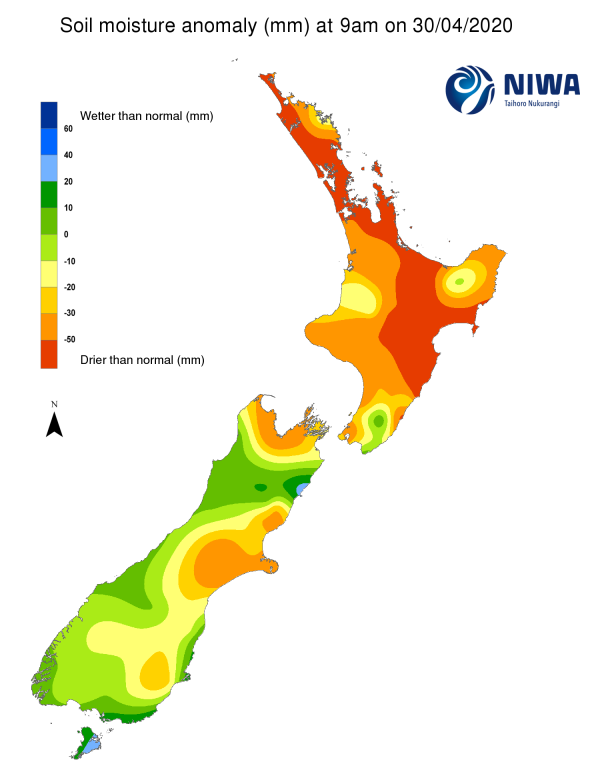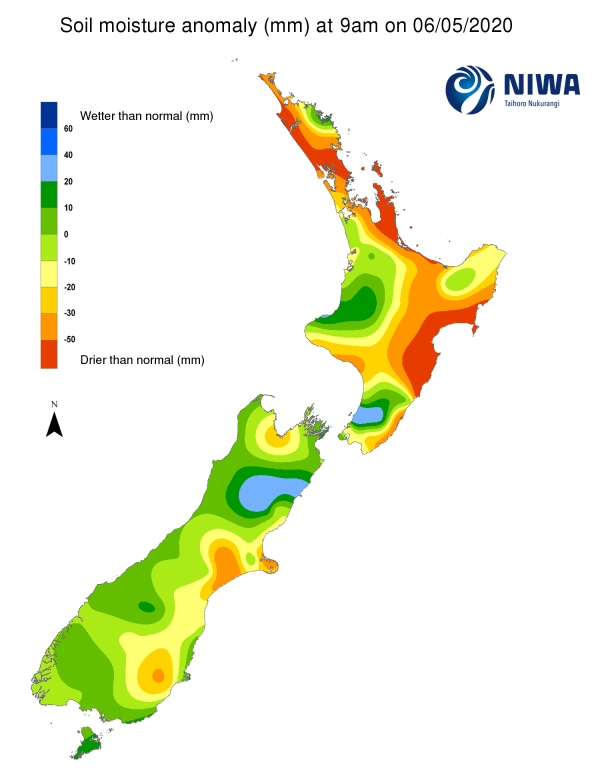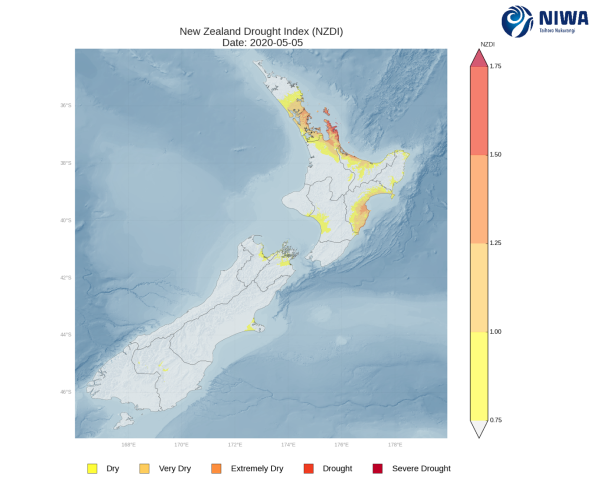A weekly update describing soil moisture patterns across the country to show where dry to extremely dry conditions are occurring or imminent. Regions experiencing significant soil moisture deficits are deemed “hotspots”. Persistent hotspot regions have the potential to develop into drought.
Please note that this will be the final Hotspot Watch update for this season. Weekly Hotspot Watches will return in the spring.
Facts: Soil Moisture
In the North Island, many areas saw moderate to heavy rainfall of 40 mm or more during the past week, particularly in northern, central, and western areas of the island. The one main exception was the east coast, where amounts of 15 mm or less were generally observed. This resulted in widespread moderate to large soil moisture increases in the areas that received the heaviest rainfall, especially across Waikato, Taranaki, and Kapiti Coast. Conversely, little soil moisture change was observed along the east coast. The driest soils across the North Island, when compared to normal for this time of the year, are found in western Northland, the Coromandel Peninsula, southern Gisborne, and much of Hawke’s Bay. Meanwhile, the wettest soils for this time of the year are located in Kapiti Coast. The New Zealand Drought Index (NZDI) shows that meteorological drought remains in place across parts of the Coromandel Peninsula (see NZDI map).
Due to the past week’s rainfall, hotspot coverage generally decreased across the North Island. However, hotspots are still found across parts of western Northland, southern Hastings, Central Hawke’s Bay, and a part of Mahia Peninsula.
In the South Island, heavy rainfall of more than 75 mm was observed across nearly all of the West Coast and Tasman during the past week, with portions of Marlborough receiving more than 50 mm as well. However, it was a dry week from central Canterbury to Southland, where amounts were generally 15 mm or less. This resulted in most areas seeing moderate soil moisture increases, although slight decreases occurred in Otago and parts of Southland. The driest soils in the South Island compared to normal for this time of the year are located in parts of Banks Peninsula and central Canterbury, while the wettest soils for this time of the year are found in far northern Canterbury. The NZDI shows that meteorological drought is not found in the South Island (see NZDI map).
Currently, the only official hotspots in the South Island are located around Christchurch and coastal Ashburton District.
Outlook and Soil Moisture
In the North Island, high pressure sitting overhead will result in the next several days being mostly, if not entirely, dry. By the middle of next week (approx. 13 May), low pressure passing north of New Zealand may bring light rain to the upper North Island, but amounts are not expected to be significant at this time. Very meagre rainfall amounts are likely across most of the North Island during the next week, with many locations likely to receive 5 mm or less. With a developing northerly flow and low pressure passing nearby next week, isolated parts of the upper North Island may receive 15 mm or less.
Minimal rainfall in the next week will likely result in near-universal soil moisture decreases across the North Island, particularly in central and southern regions. Current hotspots are likely to expand, and additional hotspots may re-emerge in Manawatu-Whanganui, the Coromandel Peninsula, and parts of Auckland.
In the South Island, mostly dry weather will be commonplace through the upcoming weekend (9-10 May). The exception will be the West Coast, where scattered showers over the next few days will bring moderate rainfall. An approaching front may bring more substantial rainfall to the West Coast early next week, although little rain is expected to reach areas east of the Southern Alps. While total rainfall could exceed 100 mm in parts of the West Coast, amounts of 10 mm or less are likely in the rest of the South Island.
Soil moisture increases will be possible in the next week along the West Coast, although minor to moderate decreases are likely in most other parts of the South Island. This will likely result in an expansion of the hotspot in central Canterbury, while a new hotspot may emerge in interior Otago.
Background:
Hotspot Watch: a weekly advisory service for New Zealand media. It provides soil moisture and precipitation measurements around the country to help assess whether extremely dry conditions are imminent.
Soil moisture deficit: the amount of water needed to bring the soil moisture content back to field capacity, which is the maximum amount of water the soil can hold.
Soil moisture anomaly: the difference between the historical normal soil moisture deficit (or surplus) for a given time of year and actual soil moisture deficits.
Definitions: “Extremely” and “severely” dry soils are based on a combination of the current soil moisture status and the difference from normal soil moisture (see soil moisture maps)
Hotspot: A hotspot is declared if soils are "severely drier than normal" which occurs when Soil Moisture Deficit (SMD) is less than -110 mm AND the Soil Moisture Anomaly is less than -20 mm.
Pictured above: Soil Moisture Anomaly Maps, relative to this time of year. The maps show soil moisture anomaly for the past two weeks.
New Zealand Drought Index (NZDI)
As of 4 May, the New Zealand Drought Index (NZDI) map below shows that meteorological drought remains in place across parts of the Coromandel Peninsula. Meteorological drought is no longer found in the South Island. Please note: some hotspots in the text above may not correspond with the NZDI map. This difference exists because the NZDI uses additional dryness indices, including one which integrates the rainfall deficit over the past 60 days. Changes are therefore slower to appear in the NZDI compared to soil moisture anomaly maps that are instantaneously updated.




